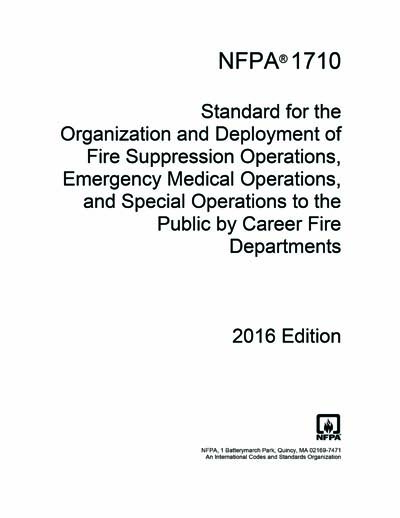Historical
NFPA 1710-2016
NFPA 1710 Standard for the Organization and Deployment of Fire Suppression Operations, Emergency Medical Operations, and Special Operations to the Public by Career Fire Departments, 2016 edition
1.1* Scope. A.1.1 In August 1953, the 35-acre General Motors HydroMatic factory in Livonia, MI, was destroyed by fire. Unprotected steel construction and the thin steel deck, which permitted the asphalt built-up roof covering to melt, drip through joints, and thereby contribute to fire spread within the building, were factors cited as responsible for the extent of the loss. The fire resulted in the largest industrial fire loss in the United States to that date. A 20 ft × 100 ft (6.1 m × 30.5 m) test structure was constructed to facilitate the analysis of the potential for contribution of roof-covering materials to fire spread within a building. Subsequent analysis consisted of a series of five large-scale fire tests utilizing different roof deck constructions, one of which represented the roof deck construction used in the General Motors factory. Based on those large-scale fire tests, a roof deck construction evaluated for the purpose of establishing limits for underdeck fire spread consisted of a built-up steel roof deck system. Based on this full-scale testing, Factory Mutual (FM) developed the fire test procedure described in Appendix B of FM 4450, Class 1 Insulated Steel Deck Roofs, and incorporated only the wood fiberboard sample (on a steel deck with a steel cover) and not the roof-covering materials. The roof-covering materials were not included because research at FM determined that they did not contribute significantly to the heat release. In a 1959 NFPA article, “The FM Construction Materials Calorimeter,” Thompson and Cousins reported on the development of the roof calorimeter test apparatus. The heat release contribution from this roof deck assembly was used to establish the 3-minute, 5-minute, 10-minute, and 30-minute average heat release limits. The wood fiberboard material used in the original test series is no longer available, but a substitute material has been identified. The wood fiberboard currently used in the test specimen provides the same heat release rate limits that are prescribed in Section 8.4. 1.1.1* This standard describes a method for determining the heat release rate from below the deck of roofing assemblies that have combustible above-deck roofing components when the assemblies are exposed to a fire from below the roof deck. A.1.1.1 This test was originally developed as a part of FM 4450, Class 1 Insulated Steel Deck Roofs. 1.1.2 The performance of the above-deck roofing assembly is evaluated by determining the heat release rate below the deck of the roof test specimen. 1.1.3* This test method is based on the substitution method for measuring the heat release rate by using an auxiliary fuel (propane) to provide the surrogate heat release rate. A.1.1.3 Additional information on substitution method calorimetry is provided in Section 3, Chapter 2 of the SFPE Handbook of Fire Protection Engineering.
Content Provider
National Fire Protection Association [nfpa]






